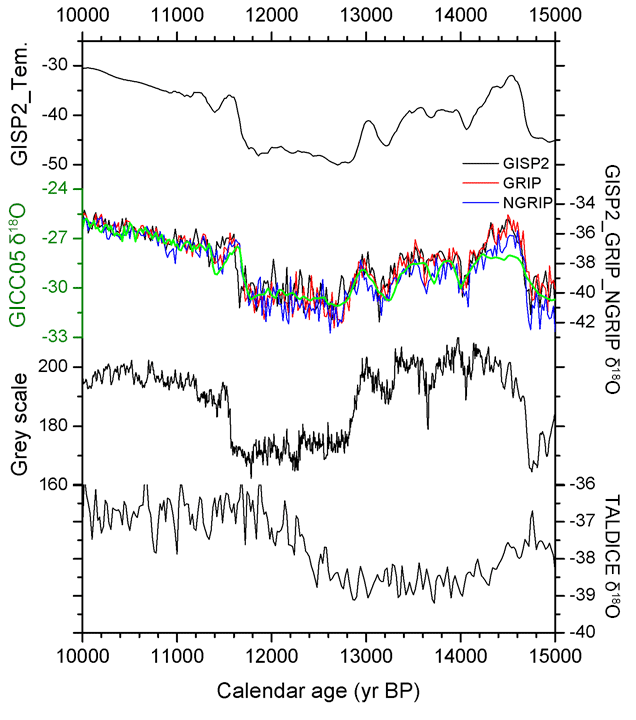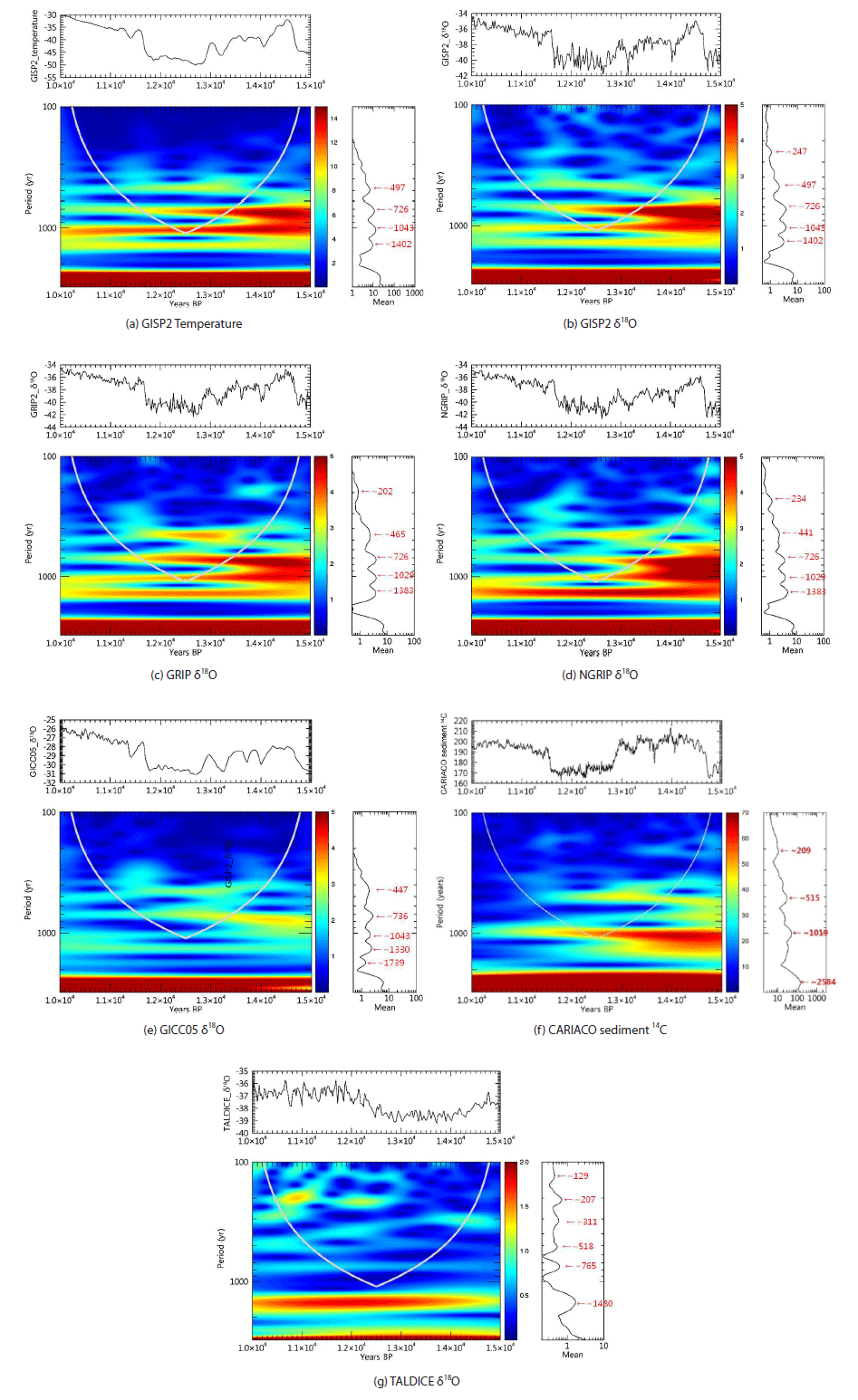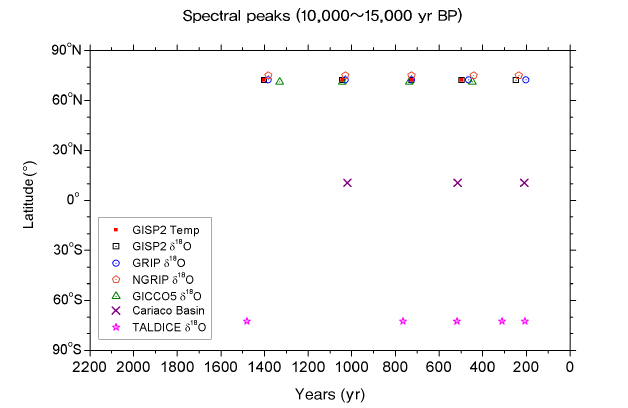1 INTRODUCTION
The Late Glacial time interval, from approximately 14,500 to 11,600 yr before present (BP), is of great interest in paleoclimate research because of the strong climate variability represented in various archives (Muscheler et al. 2008). About 14,500 yr ago, the immense ice sheets melted rapidly (Easterbrook 2012), and the Bølling–Allerød (BOA) interstadial began. This interstadial, including the Older Dryas cooling event that occurred in the middle of it, lasted from about 14,500 to 12,900 yr BP. However, it ended abruptly with the onset of the Younger Dryas (Y-D) cold period, when temperatures declined back to near-glacial levels within a decade (Wade 2006). The Y-D event has been widely studied and discussed over the last several decades, based on widespread physical and paleobotanical evidence found in the North Atlantic region (Broecker & Denton 1990). Although the climatological controls vary from site to site, this event is considered to have taken place between about 13,000 and 11,500 yr ago (Rutter et al. 2000).
In addition, millennial-scale climatic events during the last glacial–interglacial transition (LGIT) are broadly represented in terrestrial records from the both Europe (e.g., Lotter et al. 1992; Björck et al. 1996; Yu & Eicher 1998) and North America (e.g., Levesque et al. 1993; Yu & Eicher 2001). Furthermore, recent paleoclimate studies in Europe have documented three centennial-scale oscillations during the BOA interstadial (Von Grafenstein et al. 1999; Brauer et al. 2000; Zolitschka et al. 2000; Yu & Eicher 2001).
The current interglacial epoch, the Holocene, is considered to have started 11,500 yr BP, but some have suggested that this epoch may in fact have begun about 14,500 yr BP. According to this interpretation, during the interglacial period that began about 14,500 yr ago, a sudden change in climate took place about 12,800 ± 150 yr BP, caused by an air burst and impact of an asteroid or comet with the Earth, and an interval with a cold and dry climate, called the Y-D event, persisted for about 1,300 yr. Recently, magnetic nanodiamonds, which may not be generated on Earth, were discovered in geological layers all over North America corresponding to the Y-D boundary. This finding supports the hypothesis that the abrupt climate change of this time may have been caused by a cosmic impact (Kinzie et al. 2014).
In this study, we investigate the features and events of the rapid and abrupt phenomena that took place during the LGIT, and trace the global patterns and linkages of the climate changes and cycles.
2 DATA
To examine the climatic cycles and patterns, we carried out wavelet analysis using high-resolution records of 18O in ice cores and 14C in marine sediments, which have been published previously in the literature and by the World Data Center for Paleoclimatology. In general, polar ice cores have become a major climate archive for paleoclimatology, and provide a wide spectrum of information about the past climate (Schüpbach et al. 2009). In addition, radiocarbon dating is an important tool for studying the natural variability of the global climate system (Hughen et al. 2000). In this analysis, we have selected 18O records from the GRIP & NGRIP (Vinther et al. 2006), GISP2 (Stuiver et al. 1995) and CICCO5 (Rasmussen et al. 2006) of Greenland, and from the TALDICE (Stenni et al. 2011) of Antarctica. In addition, we have used 14C gray-scale data (Hughen et al. 2000) from the tropical Cariaco Basin. Cosmogenic proxy data for each region included in this analysis are as follows:
-
a) Arctic region: 18O data of the GRIP, NGRIP, GISP2, and GICC05 sites, and temperature from GISP2.
GRIP : Greenland ice core project.
NGRIP : North Greenland ice core project
GISP2 : Greenland summit ice sheet project 2.
GICC05 : Reland ice core of the Greenland Ice Core Chronology 2005
-
b) Antarctic region: 18O data of the TALDICE area (precision of ± 0.05 ‰)
TALDICE: TALos Dome Ice CorE in Antarctica (European ice core research project)
-
c) Equatorial region: Varved sediment data from the tropical Cariaco Basin
3 CLIMATE CHANGES AND FEATURES
Various abrupt changes occurred between the end of the last glacial period and the early Holocene. In particular, this study is focused on climate events and cycles that occurred in the Arctic, Antarctic, and tropical regions during the LGIT. For this purpose, Arctic and Antarctic ice-core data and marine data from the tropical region were used to investigate the climatic changes of the Y-D cool interval and the BOA warm interstadial. Fig. 1 presents the pattern of climate variations that occurred in the Arctic, Antarctic, and tropical regions from 15,000 to 10,000 yr BP.

As shown in Fig. 1, climate fluctuations with intervals of about 300–500 years are notably represented between about 15,000 and 13,000 yr BP in the Arctic and tropical regions. These centennial-scale events correspond to the Oldest Dryas (cold), Bølling (warm), Older Dryas (cold), Allrød (warm), and IACP (cold) intervals, respectively. Subsequently, the millennial-scale Y-D cold event continued for about 1,300 yr until the beginning of the Holocene. However, as represented in Fig. 1, these centennial-scale fluctuations and the Y-D event are detected in records of the Arctic and tropical regions, but not in the Antarctic TALDICE. Rather, the TALDICE records show quite a different pattern from those of the Arctic and equatorial regions. In addition, in the Y-D cold period, the initial temperature in the Arctic region was low; the temperature increased with the end of the Y-D interval, but temperature variation in the equatorial region showed the opposite tendency. To examine these features and fluctuations for each region, wavelet analysis was performed for the time interval from 15,000 to 10,000 yr BP, and the results are discussed in the following sections.
4 WAVELET ANALYSIS AND CLIMATE CYCLES
The wavelet analysis of Arctic and Antarctic 18O ice cores and tropical 14C marine records was performed for the entire time interval from 15,000 to 10,000 yr BP. The results are summarized in Fig. 2. The original data are shown above each scalogram, and the plots to the right of each scalogram represent the wavelet amplitudes averaged over the entire time period.

The wavelet results shown in Fig. 2 indicate that the main climate cycles differed between regions as well as between time intervals. In the Arctic region, cycles of ~1383–1402, ~1029–1043 and ~726–736 years were dominant for the entire time interval from about 15,000 to 10,000 yr BP, and the cycle of ~441–497 years was prominent in the time interval between about 13,500 and 11,500 yr BP. In contrast, in the tropical region, the Eddy cycle of ~1019 years was very significant for the entire time interval, and a cycle with a period of ~515 years was prominent between about 15,000 and 11,500 yr BP. In the Antarctic, however, the de Vries cycle of ~207 years was distinct between about 13,000 and 10,000 yr, and the Heinrich cycle of ~1480 years was conspicuous throughout the entire interval from 15,000 to 10,000 yr BP. In addition, the period of ~311 years shows a meaningful signal between about 15,000 and 13,000 yr BP. The major periods derived from the wavelet analysis are summarized in Table 1, which lists the centennial- and millennial-scale cycles of the observed sites.
GISP2: Greenland summit ice sheet project 2, GRIP: Greenland ice core project, NGRIP: North Greenland ice core project, GICC05: Chronology 2005 Renland ice core on the Greenland Ice Core, CARIACO: (Carbon retention in a colored oceans), TALDICE: Talos dome ice core in the Antarctic (European ice core research project)
During the LGIT, there were various abrupt and strong variations, such as the Y-D reversals and the BOA interstadial. The derived cycles listed in Table 1 reveal that a number of these events were related to centennial- and millennialscale variations, although their fluctuations show regional variations, as indicated in Fig. 3.
As shown in Table 1 and Fig. 3, the dominant climate cycles and patterns of the observed sites show the regional differences. In Arctic Greenland, the main cycles represented for the four sites differ slightly, but are nonetheless quite similar. The most significant cycles for all four sites are those with periods of ~1030–1040 years and ~720–730 years, whereas the most prominent periods are ~1020 years and ~520 years in the tropical region, and ~1480 years and ~210 years in the Antarctic TALDICE. In particular, the centennial-scale cycles of ~440–520 years and ~210 years are represented in all regions, although they show different amplitudes at each site. Among these variations, the millennial-scale Eddy cycle and the centennialscale of ~500–520 years were dominant fluctuations in the earlier half of the Holocene (Lee et al. 2014).
5 SUMMARY AND DISCUSSION
This work elucidates the features and variations of rapid and abrupt phenomena that took place from about 15,000 to 10,000 yr BP, and traces the global patterns and linkage of climatic events and cycles. The climatic changes and features during this period are summarized as follows.
-
1) Recurrent events of abrupt cooling and warming between about 15,000 and 13,000 yr BP show century-scale fluctuations of ~300–500 years in the Arctic and the tropical region, although the intervals and patterns of these events differ slightly between the two regions. However, these recurrent features were not seen in the Antarctic TALDICE records.
-
2) Subsequently, the millennial-scale Y-D event, which proceeded for about 1,300 yr, started and ended abruptly in the Arctic and tropical region, although this event also was not detected in the Antarctic records. This finding indicates that the Y-D cooling event may not have been synchronous everywhere. Regarding the forcing mechanism of the Y-D reversal, various possibilities have been suggested, such as North Atlantic thermohaline circulation associated with meltwater influx, and cosmic impact of an asteroid or comet fallen in North America. However, more conclusive evidence is still needed. If the Y-D cooling was caused by regional factors in the North Atlantic or North America, it would not have occurred globally, although it affected the climate of tropical regions.
-
3) The results of wavelet analysis show that the millennialscale Eddy cycle is dominant in the Arctic and equatorial regions, but not in the Antarctic. Instead, the millennialscale Heinrich cycle and the centennial-scale de Vries cycle were very significant in the Antarctic. In particular, the de Vries cycle showed a significant signal in the Antarctic region even in the Y-D period, which suggests that solar activity was strong despite the coolness of this period. In addition, the centennial-scale cycles of ~ 720–730 and ~ 440–500 years were very distinct in the Arctic region. The ~720–730-year cycle was modified to a weaker period of ~765 years in the Antarctic region.
-
4) In conclusion, our results show that there was climate linkage between the Arctic and tropical regions during the LGIT, but that this linkage was not global. In addition, the Y-D event may have been caused by a specific strong and abrupt factor, but it seems that its impact on the global climate was restricted. Nonetheless, a larger variety of more definitive evidence is still required to reveal the global connections and patterns of the Y-D cooling and BOA events, because their features vary widely with various factors, such as the proxy records used and regional differences.
